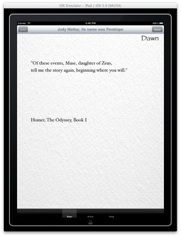ELO 2012 Media Art Show
Grigar’s Curatorial Statement
that represent a translation not only from another medium but another form: Malloy’s original work was published in 1993 as a Storyspace hypertext on diskette, while Tomasula’s, published in 2009, is a media rich novel originally published as a DVD. What is lost and gained in this rendering from one medium and form? The question beckons me as a scholar to look for answers.
This time around I also noticed fewer submissions of animated works compared to the last ELO show I curated (in 2008). Apple’s recent decision to not make Flash available for its mobile devices has rendered this once ubiquitous technology a rare commodity, at least in terms of electronic literature. Lello Masucci’s “i love you” (pictured above) constitutes one of a few submissions that utilizes Flash for the creation of the work. Even Jason Nelson, well-known for his virtuoso use of Flash, quipped during his Skype presentation at the “Readings & Performances” at the Hugo House during MLA 2012 exhibit that he was “moving on [from Flash].” Interestingly, I did notice an uptick in the use of Unity, software used to create a highly interactive game environments, among this year’s submissions. Also in growth mode is generative art; this form of electronic literature constituted one of the two largest categories (along with multimodal narratives) of submissions.
So, in curating exhibits I learn and become a much more knowledgeable scholar in this area of research.
Part 2: Layout of for This ELit Exhibit

“Electrifying Literature: Affordances & Constraints,” The ELO 2012 Media Art Show marks the second exhibit of electronic literature that I have curated in less than six months. As I have worked on it, I have also been preparing for two other elit exhibits: the MLA 2013 in Boston, MA in January 2013, and the Library of Congress Electronic Literature Showcase in D.C. in March 2013. All total, I will have curated nine exhibits since 2005, all but three of them related directly to electronic literature. Undertaking so many shows begs the question, “why curate elit?” (and perhaps so much of it?). One answer that ties into the theme of the ELO 2012 conference is that such access and proximity to artists and their work raise my awareness of the affordances and constraints bound up in the technologies we use to produce our work and, so, makes me a better scholar of electronic literature.
For example, in organizing the 160 works my co-curators (Kathi Inman Berens and Lori Emerson) and I exhibited at the MLA 2012 exhibit, I was struck by the work of Argentinian artist Ana Maria Uribe. In 1968 she experimented with concrete poetry, moving from the medium of printed page to the computer screen. The work from this period, aptly entitled “Typoems,” features ascii characters; sound, movement, and even visual features like color, were not yet available. Later, in 1997, as computer technology became more robust, she shifted her attention to animating her work, moving from concrete to kinetic poetry, the affordances of the medium providing new landscapes to explore. “Anipoems,” the work generating from this period, are mesmerizing to read––and watch––the playfulness of movement giving voice to her wry wit.

Lello Masucci, “I Love You”
Part 1: Why Curate ELit?